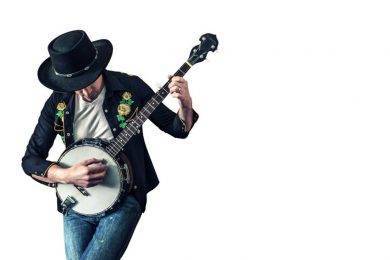Much like thumb picks that are also used for playing the banjo, you would need to have fingerpicks made from metal so you can play as well. These banjo picks are designed with a striking surface shaped like a blade, and this is then joined to a special collar that can keep the pick around your finger’s end. You can then fit these banjo picks onto your middle and index fingers, allowing the surface that strikes the banjo to be on the opposite side from where your fingernail is. But what else should you know about banjo picks, especially if you are a beginner banjo player, and how can you choose the best ones for your needs? Here’s your definitive guide.
The Basics on Banjo Picks
There are many banjo picks now available, and they differ in terms of their thicknesses and sizes and their metal material. Some of the unique banjo picks feature a curved surface for striking, while some feature flat blades. Other kinds of banjo picks are designed with holes, while others don’t have any holes at all.
The best thing you can do is try out different kinds of banjo picks so you know which ones can fit you more suitably and comfortably. But more importantly, trying out different types will allow you to choose the one that sounds exactly right with your banjo.
Their Price
The good news is that since there are various kinds of banjo picks available; they come with varying prices. Anyone will find it relatively easy to buy picks for as low as $3 for each pair, but there are some banjo picks that can cost a bit higher – up to $35, especially if you go for banjo picks crafted by hand and made from stainless steel.
Trying Them on for Size
When you’re trying your banjo picks, one tip is to bend them so you can get a suitable fit. These banjo picks don’t often come directly from the shop, ready for anyone to use right away. In other words, you would have to modify them a little bit first.
- The first thing you should do is place the banjo pick at your finger’s end, and make sure to put the collar of the pick right between your finger’s end and your first joint. Avoid placing the collar on the finger joint; this will set it too far up.
- Once you have placed the pick on your finger, grasp both sides of the banjo pick collar using your index finger and your left thumb, and then squeeze it, so it fits snugly but not too tightly. Make sure the blade extends just a little past your finger’s end, and if it already fits quite well, you can use it, but many players prefer bending the blade a little bit back, so it matches their finger’s natural curve.
- You can bend the banjo pick’s blade (providing it isn’t cumbersome) if you push the banjo pick down against a hard surface, like a tabletop.
- Some players also make a particular modification to their banjo picks by fitting the pick onto their finger with a slight angle. This way, when their finger begins striking the string, their banjo pick will meet the banjo string at a more parallel and straighter angle.
My name is Sardar Ayaz a professional content writer and SEO expert having Proven record of excellent writing demonstrated in a professional portfolio Impeccable grasp of the English language, including idioms and current trends in slang and expressions. I have ability to work independently with little or no daily supervision with strong interpersonal skills and willingness to communicate with clients, colleagues, and management.
I can produce well-researched content for publication online and in print, organize writing schedules to complete drafts of content or finished projects within deadlines. I have 12 years’ experience to develop related content for multiple platforms, such as websites, email marketing, product descriptions, videos, and blogs.
I use search engine optimization (SEO) strategies in writing to maximize the online visibility of a website in search results











